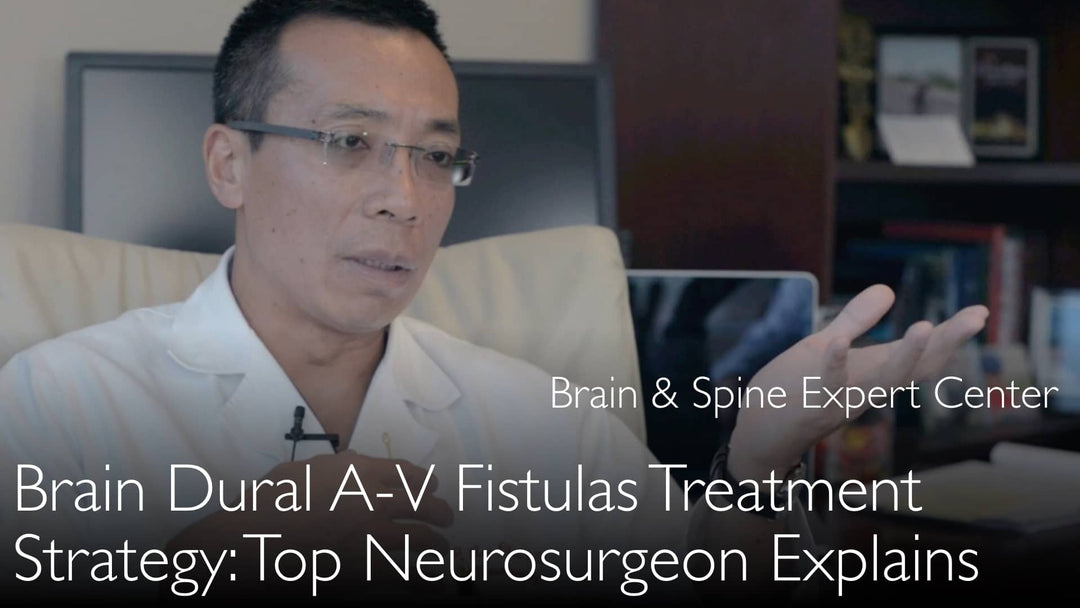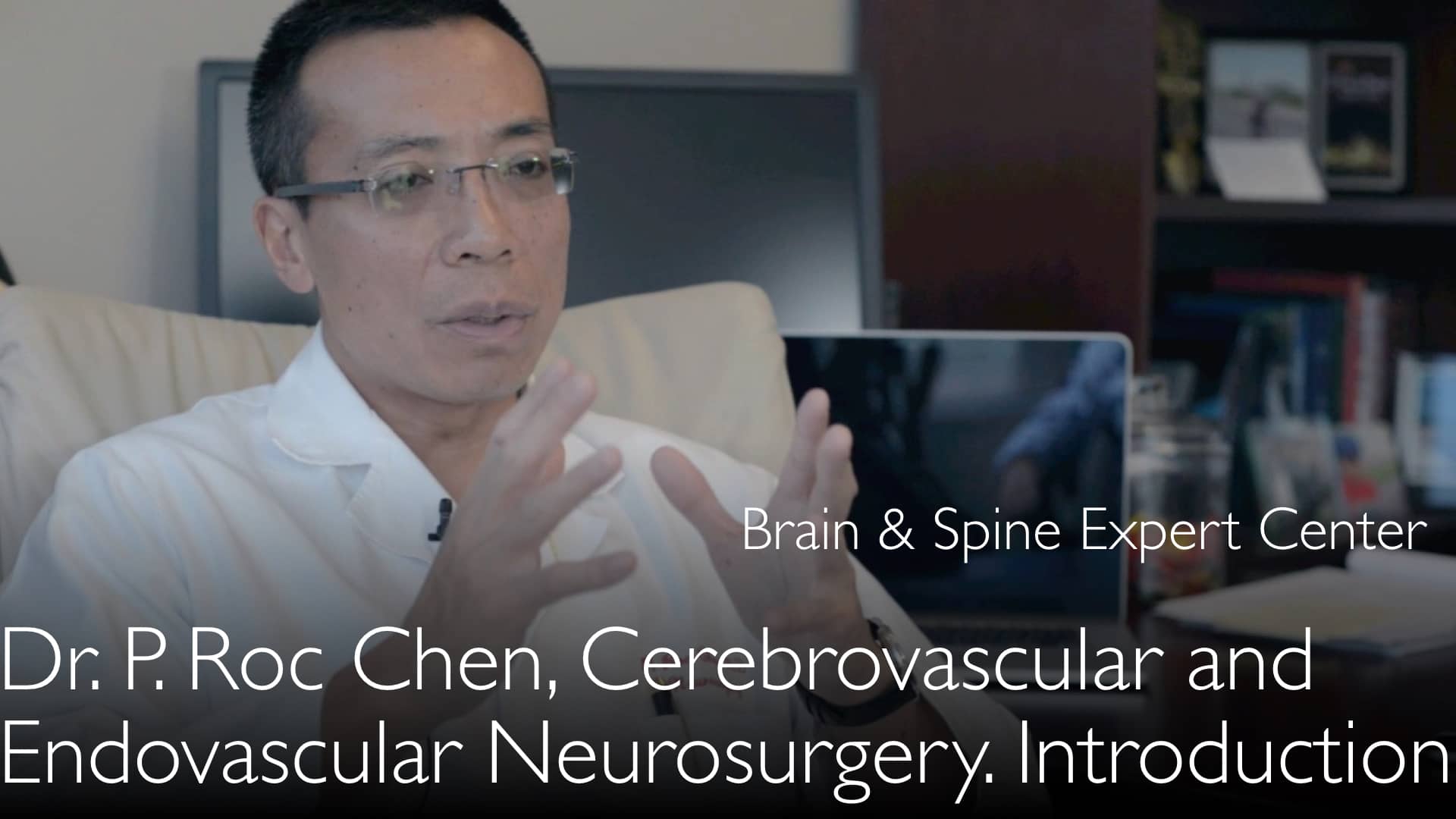Leading expert in cerebrovascular neurosurgery, Dr. Peng Chen, MD, explains the complex decision-making process for treating brain dural arteriovenous fistulas (BDAVF) and cerebral cavernous malformations. He details how treatment strategies, including vigilant observation, endovascular embolization, and open brain surgery, are tailored to each patient's specific risks of bleeding and symptoms. Dr. Peng Chen, MD, emphasizes that a careful assessment of the individual's condition is paramount, and a multimodal approach combining techniques often yields the best outcomes for these challenging cerebrovascular diseases.
Brain Dural Arteriovenous Fistula and Cavernous Malformation Treatment Options
Jump To Section
- BDAVF Treatment Overview
- Endovascular Embolization for BDAVF
- Symptoms and Observation for BDAVF
- Cavernous Malformation Bleeding Risk
- Surgical Removal of Cavernomas
- Complex Brain Lesion Locations
- Multimodal Treatment Approach
- Patient Assessment and Decision
BDAVF Treatment Overview
Brain dural arteriovenous fistula treatment involves a critical choice between continued observation and active intervention. As Dr. Peng Chen, MD, explains, these fistulas are a specific subtype of vascular malformation. The decision to treat is based on a thorough evaluation of the individual patient's risk of adverse events like bleeding or stroke.
Endovascular Embolization for BDAVF
Endovascular neurosurgery is a highly effective primary treatment method for many brain dural arteriovenous fistulas. Dr. Peng Chen, MD, states that approximately 85% of BDAVF cases can be addressed with endovascular embolization. This minimally invasive procedure, performed through an artery or vein, can successfully occlude the fistula, allowing patients to recover well.
Symptoms and Observation for BDAVF
Some brain dural arteriovenous fistulas present a very low immediate risk of bleeding into the brain. However, they can cause debilitating symptoms that significantly impact quality of life. Dr. Peng Chen, MD, notes that common issues include pulsatile tinnitus, a constant noise in the ear that leads to sleep problems and forces patients to change their lifestyle. For fistulas with low bleeding risk but high symptom burden, the decision between treatment and observation requires careful discussion.
Cavernous Malformation Bleeding Risk
Cerebral cavernous malformations, or cavernomas, carry a different risk profile than dural fistulas. The typical risk of hemorrhage from a cavernous malformation is between 1% to 5% per year. Dr. Peng Chen, MD, emphasizes that this bleeding risk is heavily influenced by the lesion's location within the brain, which is a major factor in deciding whether to proceed with treatment.
Surgical Removal of Cavernomas
For symptomatic cavernous malformations, surgical removal is often a safe and successful treatment option. Seizures can be a primary symptom of cavernomas in certain brain locations. A skilled neurosurgeon can achieve excellent results with microsurgical resection for many of these lesions, effectively eliminating the source of the seizures and the risk of future bleeding.
Complex Brain Lesion Locations
Treatment decisions become exceptionally complex for vascular malformations located in deep or eloquent areas of the brain. A brainstem cavernous malformation or a cavernous angioma of the basal ganglia are two examples of lesions that are notoriously difficult to treat surgically. Dr. Peng Chen, MD, stresses that managing these requires a skull base neurosurgeon with sophisticated surgical skills and experience to achieve a good outcome while minimizing risk.
Multimodal Treatment Approach
The most advanced strategy for complex cerebrovascular diseases often involves a combination of treatments. For brain dural arteriovenous fistulas that are not amenable to endovascular methods alone, a combination of endovascular embolization and open brain surgery can be used. Dr. Chen is a strong proponent of this multimodal approach, believing that leveraging the strengths of different techniques offers the most balanced and effective path to successful treatment.
Patient Assessment and Decision
The cornerstone of managing any cerebrovascular disease is a meticulous and correct assessment of the patient's individual situation. Dr. Peng Chen, MD, strongly emphasizes that there is often no black-and-white answer. The neurosurgeon must carefully weigh the risks of treatment against the risks of the natural progression of the disease. This crucial decision-making process determines not only whether to treat but also how to treat, ensuring the chosen modality is the best for that particular patient.
Full Transcript
Dr. Anton Titov, MD: Brain dural arteriovenous fistula treatment decisions involve continued observation or complex neurosurgical operation. What are the relative risks of bleeding from BDAVF? Sometimes endovascular neurosurgery is a preferred treatment method.
Brain dural arteriovenous fistula treatment includes endovascular embolization and open brain surgery. Cerebral dural arteriovenous fistula causes include an unknown vascular event that caused fistula formation.
Dr. Peng Chen, MD: Brain dural arteriovenous fistulas are classified as "subtype 1" of the classification of the general vascular malformation category. Eighty-five percent of brain dural arteriovenous fistulas can be treated with endovascular embolization.
Embolization of brain dural arteriovenous fistula via artery or vein can be very successful in patients, and patients can do very well. Some brain dural arteriovenous fistulas (BDAVF) have a very low risk of repeat bleeding into the brain.
But BDAVF can cause constant noise in the ear. Patients with dural AV fistula might not sleep well. They have to change their lifestyle.
Some patients with brain dural arteriovenous fistulas (BDAVF) have very troublesome symptoms. They have a risk of bleeding into the brain. Those patients deserve good treatment, such as endovascular embolization of brain dural arteriovenous fistula.
Endovascular embolization methods do not work well for several specific subtypes of brain dural arteriovenous fistula. Neurosurgical treatment is the best method to help those patients.
For some patients, a combination of endovascular embolization and open brain surgery can be used. Very good results can be achieved by combining endovascular and open neurosurgery methods to treat some BDAVF.
For cerebral cavernous malformation, the risk of hemorrhage (bleeding) is higher. The typical risk of bleeding from cerebral cavernous malformation is 1% to 5% per year. Risk of bleeding from cavernoma depends on its location in the brain.
Some cerebral cavernous malformations can be observed. Treatment of other cerebral cavernous malformations can be safe and successful. Seizures can be a symptom of cerebral cavernous malformations in some locations.
Surgical removal of cavernomas is possible for many locations of the brain. Sometimes a patient has seizures. Brainstem cavernous angioma is a difficult location to treat such lesions.
Brain cavernous malformation is located inside the brainstem. Also, cavernous malformation of the basal ganglia is another example of cerebral cavernous angioma that is difficult to treat. The decision has to be made very carefully and judiciously.
A skull base neurosurgeon must have very sophisticated surgical skills to treat these cavernous angiomas successfully. It is important to make a crucial decision whether to continue to observe brainstem cavernous malformation and basal ganglia cavernous malformation.
You sometimes have to treat these lesions surgically. Sometimes a skull base neurosurgeon decides to treat the lesions surgically. Some surgeons can achieve very good treatment results.
Let us summarize our discussion about brain dural arteriovenous fistulas and cerebral cavernous malformations. It is very important to assess the risk of adverse events (bleeding, stroke) correctly for a particular type of patient.
You must do a careful and full assessment of the patient's situation. A decision to continue observation or to proceed with active treatment can be made.
The combination of open brain neurosurgical operations and endovascular embolization methods to treat brain dural arteriovenous fistulas or cerebral cavernous malformations is used. It can often achieve the best results for the patient.
Matching of skill and experience of the neurosurgeon with the difficulty level and location of the patient's lesion is crucial. This is how you achieve the best treatment results.
Yes, that is exactly correct. I strongly emphasize that a very careful and correct assessment of the patient's individual situation is key to successful treatment of any cerebrovascular disease.
It is important to use principles of evidence-based medicine to evaluate and treat patients with cerebrovascular disease. However, for many cerebrovascular diseases, there is no high-quality evidence about the best approaches to treatment of patients.
There are many specific situations. It includes treatment of brain dural arteriovenous fistulas or cerebral cavernous malformations. There is still controversy about the best methods of treatment of many cerebrovascular diseases.
Because of this controversy, most situations of cerebrovascular disease are not black or white. Most cases of cerebrovascular disease require careful assessment of the balance between risks of treatment and risks of natural progression of the disease.
That includes treatment of brain dural arteriovenous fistulas or cerebral cavernous malformations. Brain vascular malformations cause bleeding or seizures.
Sometimes the risk of complications from the progression of the disease process is higher than the risk of surgical operation or endovascular treatment. Then you know the correct answer about what to do.
But it is crucially important to determine. The best modality of treatment has to be the best for this particular patient. Then a surgeon can choose the less risky modality to treat this patient.
It may be open brain surgery or endovascular embolization. The decision whether to treat the patient is crucial. How to treat the patient is particularly important for those patients.
They have the cerebrovascular problem that was discovered by accident. These patients may face the risk of problems from their cerebrovascular disease. Brain dural arteriovenous fistulas or cerebral cavernous malformations can happen in the future.
It is very important to correctly determine their brain bleeding risk. Treatment of cavernous angiomas and brain dural fistulas is very much evolving.
I think that multimodality treatments are the best. It is a combination of open neurosurgery and endovascular treatment. It is the most balanced way to treat patients with cerebrovascular problems.
It will be best for the patients in many situations. Brain dural arteriovenous fistula treatment: intervene or observe? Endovascular embolization or open brain surgery? Combination? How to find a neurosurgeon?





